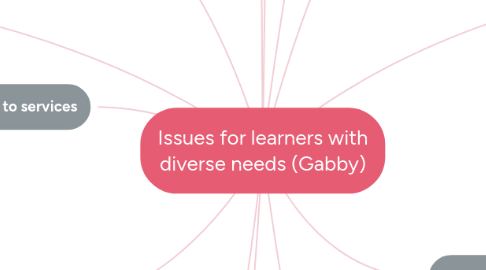
1. Quality of education
1.1. Everyone has the right to be included (DET, 2018)
2. Workforce capacity
2.1. Teachers, support staff, Principal, leadership
2.1.1. Having everyone on board (DET, 2018)
2.2. Negative attitudes
2.2.1. Need to value difference as a positive (CDA, 2015
2.2.1.1. Create a culture of this within school communities (CDA, 2015)
2.2.2. Major barrier to educational opportunities and freedom from discrimination (DEEWR, 2012)
2.3. Inability focus on disability - rather than ability focus
2.3.1. Need to focus on individual strengths (DET, 2018)
2.4. Teacher education
2.4.1. Skills development is a cost effective method for improving student outcomes (NDPCC, 2009)
2.4.2. Lack of expertise/training in inclusive education (CDA, 2015)
2.4.2.1. Lack of training = interventions/supports are not evidence based
3. Student assessment & outcome measures
3.1. Assessment tasks tailored to student needs (DET, 2018)
3.2. No consistent means of accurately measuring progress of students with disability who require modifications exists (CDA, 2015)
3.2.1. Gaps in national data on issues related to educational achievement of students with disability
3.3. Standardised testing
3.3.1. Culturally appropriate standardised testing (MACSD, 2003)
3.3.1.1. Standardised tests are based on expectations of understanding of non-Aboriginal children
3.3.2. Students with disabilities are often left out of standardised testing such as the NAPLAN (CDA, 2015)
4. Social experience
4.1. Bullying
4.1.1. Persistent and chronic experience for many students (CDA, 2015)
5. Individualised planning
5.1. Educational needs to be considered alongside physical, intellectual and cultural needs (CADSS, 2017)
5.2. Inconsistent implementation of IEPs (CDA, 2015)
5.2.1. Inconsistent inclusion of family, student and other important stakeholders (CDA, 2015)
6. Aboriginal culture/heritage
6.1. Indigenous Australians have higher rates of disability than non-Indigenous Australians across all age groups (ABS, 2012)
6.2. Different learning needs, experiences, goals and styles (AbSec, 2018)
6.3. Common barriers to education of Aboriginal children
6.3.1. Not enough Aboriginal history/culture integrated into learning content (Korff, 2018)
6.3.2. Poor teaching quality (Korff, 2018)
6.3.3. Lack of full time, consistent teachers, Korff, 2018)
6.4. Social disadvantages
6.4.1. Grief/loss of removal from parents
6.4.2. Cultural lack of trust in authorities due to history of mistreatment (MACSD, 2003)
6.4.3. Fear of discrimination or stigma (CADSS, 2017)
6.5. Aboriginal concept of disability
6.5.1. Difference in how disability is viewed (MACSD, 2003)
6.5.1.1. Vs. Western medical deficit model of disability (MACSD, 2003)
7. Access to services
7.1. Need for early intervention
7.2. Health and education needs do not operate independently (MACSD, 2003)
8. Attendance
8.1. Choice of schools to attend is limited
8.2. Capacity of schools to provide appropriate support on a full-time basis is limited (CDA, 2015)
9. Funding
9.1. Current system lacks appropriate resources and funding (NDPCC, 2009)
9.1.1. Lack of funding narrows choices for students with disabilities and their family/carers (NDPCC, 2009)
9.1.2. Barrier to educational achievement (CDA, 2015)
10. Exclusion & segregation
10.1. Exclusion from education experiences (CDA, 2015)
10.1.1. Excursions
10.1.2. Learning experiences in the classroom with peers
10.1.3. Segregation - always working with support staff rather than other students and classroom teacher
11. Rural location
11.1. Less access to services (e.g. OT, speech therapy, specialised education support)
11.2. Implications of distance
11.2.1. Less choice of schools to attend
11.2.2. Less opportunity for collaboration between family/home & school due to distance
11.2.3. Travel costs involved in accessing services over long distances
11.3. Difficulty in attracting and retaining quality teachers & support staff (Australian Human Rights Commission, 2001)
11.4. Limited funding and inadequate provision of equipment, tools and resources (Australian Human Rights Commission, 2001)
12. Gabby's circumstances
12.1. Rarely participates in class activities
12.2. 'Loner'
12.3. Rural location
12.4. Aboriginal heritage
12.4.1. Unsure of where her people are from
12.4.2. Has a good understanding of her culture
12.5. Not in the care of her parents
12.5.1. In the care of her Aunty
12.6. Foetal Alcohol Syndrome
12.7. Difficulties with writing and some aspects of literacy
12.8. Strengths
12.8.1. Drama
12.8.1.1. Sport
13. School experience
13.1. Same opportunities for all students (DET, 2018)
13.2. Quality education = social and emotional development, place, identity (NPDCC, 2009)
13.3. Cultural expectations and relationship with schools (MACSD, 2003)
13.3.1. Between families
13.3.2. Connection to Aboriginal culture
13.3.2.1. Family and social connection is essential to Aboriginal culture
13.3.3. Some aspects of school are in contrast to community and home ways of living

